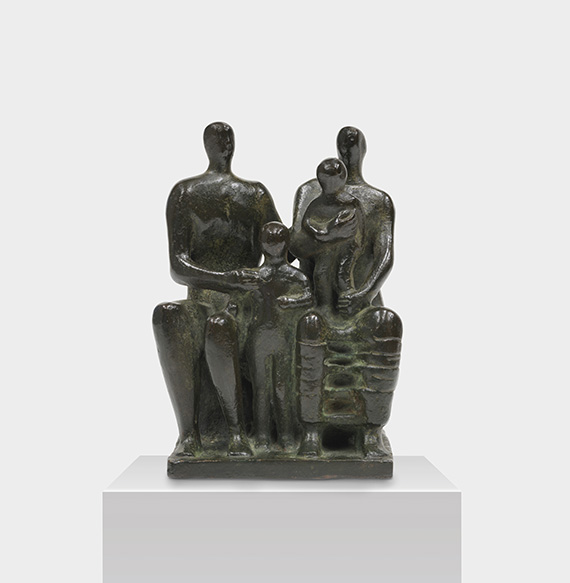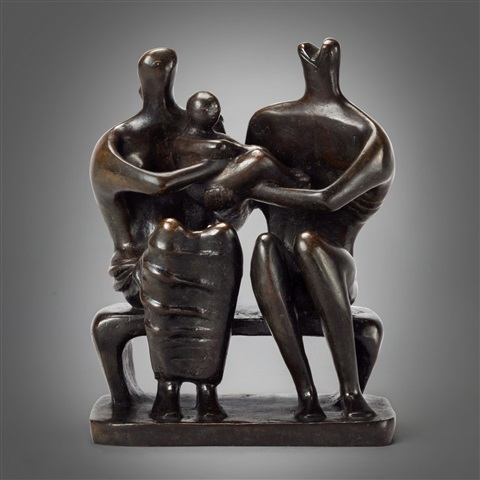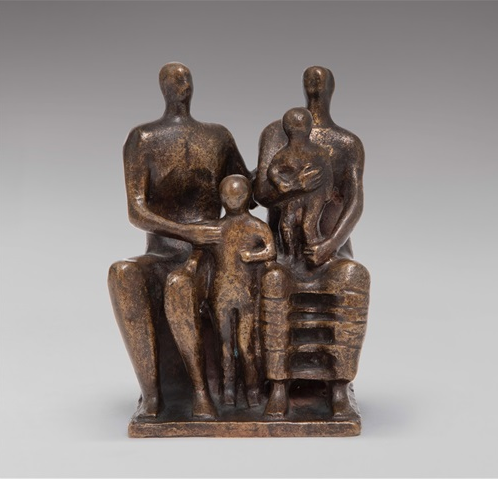Vente: 550 / Evening Sale 07 juin 2024 à Munich  Lot 124000460
Lot 124000460
 Lot 124000460
Lot 124000460
Autre image
Autre image
Autre image
Autre image
Autre image
Autre image
124000460
Henry Moore
Family Group, 1944.
Bronze with brown patina
Estimation: € 300,000 / $ 321,000
Les informations sur la commission d´achat, les taxes et le droit de suite sont disponibles quatre semaines avant la vente.
Family Group. 1944.
Bronze with brown patina.
From an edition of nine copies (plus one artist copy). 15.2 x 10.7 x 7.5 cm (5.9 x 4.2 x 2.9 in).
Cast by Art Bronze Foundry (Gaskin's), London, in 1956.
• Family is a key theme in the artist's oeuvre.
• The early "Family Group" series (1944-1949) is considered the first independent realization of this motif in bronze and was showcased in Moore's first solo exhibition at the Museum of Modern Art in New York in 1946.
• This "Family Group" is one of the first works in this important group and is therefore much sought-after.
• In its closed form and perfect harmony, it is one of the most compelling versions of the motif.
• Moore transfers the traditional archetype of the family into an intimate, multi-figure scene with a profoundly modern expressiveness.
• Two copies of this work are in the Hirshhorn Museum and Sculpture Garden, Washington, and the Dallas Museum of Art.
Accompanied by a photo certificate of authenticity that is signed and dated by the artist, Fischer Fine Art Ltd., London, from September 1976.
The work is documented at the Henry Moore Foundation, Hertfordshire, with the number LH 230.
PROVENANCE: Fischer Fine Art Ltd., London.
Dr. Theo Maier-Mohr Collection (acquired from the above in 1976).
Ever since family-owned.
EXHIBITION: Henry Moore. Natur und Figur, Museum Lothar Fischer, Neumarkt i. d. Opf., October 17, 2010 - January 9, 2011.
LITERATURE: Herbert Read, Henry Moore. Sculpture and Drawings, vol. 1, London 1949 (3rd edition), no. 70 h (terra-cotta, illu. in black and white).
David Sylvester (ed.), Henry Moore. Sculpture and Drawings, vol. 1 (1921-1948), London 1957 (4th edition), no. 230 (terra-cotta, illu. in black and white, p. 144).
David Sylvester (ed.), Henry Moore. Complete Sculpture, vol. 1 (1921-1948), London 1988 (5th edition), no. 230 (terra-cotta, illu.).
- -
Ex. cat. Henry Moore, Tate Gallery, London 1968, cat. no. 62 (illu. of a different copy).
Ex. cat. Henry Moore. Sculpting the 20th Century, Dallas Museum of Art, Dallas, Fine Arts Museums of San Francisco, National Gallery of Art, Washington D.C., 2001-2002, cat. no. 49 (illu. of a different copy).
Lewis Lapham (ed.), Lapham's Quarterly, New York, winter 2012, vol. 5, first edition (illu. in color on the cover, different copy).
"I found inspiration for the Family Groups in sketching, perhaps because this theme touched me so deeply. It was shortly before our first daughter Mary was born."
Henry Moore, quoted from: Henry Moore, Maquetten, Munich 1978, p. 72.
Bronze with brown patina.
From an edition of nine copies (plus one artist copy). 15.2 x 10.7 x 7.5 cm (5.9 x 4.2 x 2.9 in).
Cast by Art Bronze Foundry (Gaskin's), London, in 1956.
• Family is a key theme in the artist's oeuvre.
• The early "Family Group" series (1944-1949) is considered the first independent realization of this motif in bronze and was showcased in Moore's first solo exhibition at the Museum of Modern Art in New York in 1946.
• This "Family Group" is one of the first works in this important group and is therefore much sought-after.
• In its closed form and perfect harmony, it is one of the most compelling versions of the motif.
• Moore transfers the traditional archetype of the family into an intimate, multi-figure scene with a profoundly modern expressiveness.
• Two copies of this work are in the Hirshhorn Museum and Sculpture Garden, Washington, and the Dallas Museum of Art.
Accompanied by a photo certificate of authenticity that is signed and dated by the artist, Fischer Fine Art Ltd., London, from September 1976.
The work is documented at the Henry Moore Foundation, Hertfordshire, with the number LH 230.
PROVENANCE: Fischer Fine Art Ltd., London.
Dr. Theo Maier-Mohr Collection (acquired from the above in 1976).
Ever since family-owned.
EXHIBITION: Henry Moore. Natur und Figur, Museum Lothar Fischer, Neumarkt i. d. Opf., October 17, 2010 - January 9, 2011.
LITERATURE: Herbert Read, Henry Moore. Sculpture and Drawings, vol. 1, London 1949 (3rd edition), no. 70 h (terra-cotta, illu. in black and white).
David Sylvester (ed.), Henry Moore. Sculpture and Drawings, vol. 1 (1921-1948), London 1957 (4th edition), no. 230 (terra-cotta, illu. in black and white, p. 144).
David Sylvester (ed.), Henry Moore. Complete Sculpture, vol. 1 (1921-1948), London 1988 (5th edition), no. 230 (terra-cotta, illu.).
- -
Ex. cat. Henry Moore, Tate Gallery, London 1968, cat. no. 62 (illu. of a different copy).
Ex. cat. Henry Moore. Sculpting the 20th Century, Dallas Museum of Art, Dallas, Fine Arts Museums of San Francisco, National Gallery of Art, Washington D.C., 2001-2002, cat. no. 49 (illu. of a different copy).
Lewis Lapham (ed.), Lapham's Quarterly, New York, winter 2012, vol. 5, first edition (illu. in color on the cover, different copy).
"I found inspiration for the Family Groups in sketching, perhaps because this theme touched me so deeply. It was shortly before our first daughter Mary was born."
Henry Moore, quoted from: Henry Moore, Maquetten, Munich 1978, p. 72.
Preceding the "Family Groups": Mother and Child Figures and "Shelter Drawings"
The family is an important motif in the art of every culture, and it also occupies an eminent position in Henry Moore's oeuvre, for which the human figure was formative. As early as in the 1920s, at the beginning of his artistic career, Moore addressed the theme in his mother-and-child figures and repeatedly revisited it in sculptures and graphic works up into the 1980s.
During World War II, Moore made drawings of people seeking shelter from air raids in the London subway, they are known as his "Shelter Drawings". In these works, Moore also depicts the intimacy of huddled family members, siblings sleeping side by side, mothers holding their children tight.
After his studio was destroyed, Moore and his wife Irina (married 1929) moved to Perry Green in Hertfordshire in 1941, where he would live and work for the rest of his life (today seat of the Henry Moore Foundation). In 1942, the artist received a commission for a mother and child figure for St. Matthews Church in Northampton, which he completed in 1944. A work in which Moore also took a modern, contemporary approach to the traditional, iconographic subject.
The Idea Behind the "Family Group"
The project was followed by another public sculpture: before the outbreak of the war, Moore had already received an offer from the German architect and Bauhaus founder Walter Gropius, who was living in England, asking him to design a sculpture with a family theme for the school in Impington (near Cambridge) that Gropius and Maxwell Fry planned in 1935/36. In search of a suitable composition, a sculptural solution that would put equal value on parents and children, Moore had already made a number of drawings. The building, which opened in 1939, was not only conceptualized as a mere school building, but also include flexible spaces that could accommodate families. Initially, there was no funding for Moore's sculpture, however, Henry Morris, then Education Officer for the Cambridgeshire County Council, brought the sculpture back onto the agenda in 1944. With great artistic energy and creativity, Moore filled almost two complete sketchbooks with drawings and produced more than two dozen clay or terracotta models in which he grouped the figures in various postures, forms and constellations. He then had ten of these different models cast in bronze, although the project could not be realized this second time around, either.
In its basic conception, the "Family Groups" are made up of several figures, two adults and one or two children of different ages, forming a cohesive, stable unit. While some figures appear quite lively, others are much more static. This present "Family Group" (LH 230) can well be deemed one of the most striking versions, as its closed form reveals a particularly balanced composition. The broad shoulders and strong, parallel legs of the seated figures convey stability, while their physical contact and their joint gaze in the same direction testify to their strong bond.
Desire and Fulfillment: the Longing for Harmony and Stability
In the years of the war and its aftermath, many artists were far from depicting intimacy, tenderness or even humanity in such a direct way. Yet especially in a time when many families were irretrievably torn apart, Moore succeeded in conveying a sense of hope and the desire for peace and stability with his unmistakable "Family Groups", a dream that seemed to be within reach at the time, yet still a long way off. It is possible that Moore's appreciation of family values and his perception of family as a source of peace and harmony were shaped in his own childhood: "Perhaps the family groups reflect this outlook. [..] no doubt, my own childhood would have an influence. I was the seventh child of a family of eight, my childhood was very full and very happy." (Henry Moore in a letter to Evelyn S. Ringold, February 24, 1975, Henry Moore Foundation Archive)
With the end of the war, Henry Moore's personal and professional future also took a turn for the better. After several miscarriages, the birth of their daughter Mary in 1946 fulfilled their long-cherished wish to have children. In the same year, the Museum of Modern Art in New York presented a comprehensive solo exhibition, which was also shown at the San Francisco Museum of Art and the Chicago Art Institute the following year. In 1948, Henry Moore featured in the British Pavilion at the 24th Biennale di Venezia and was awarded the International Prize for Sculpture. [CH]
The family is an important motif in the art of every culture, and it also occupies an eminent position in Henry Moore's oeuvre, for which the human figure was formative. As early as in the 1920s, at the beginning of his artistic career, Moore addressed the theme in his mother-and-child figures and repeatedly revisited it in sculptures and graphic works up into the 1980s.
During World War II, Moore made drawings of people seeking shelter from air raids in the London subway, they are known as his "Shelter Drawings". In these works, Moore also depicts the intimacy of huddled family members, siblings sleeping side by side, mothers holding their children tight.
After his studio was destroyed, Moore and his wife Irina (married 1929) moved to Perry Green in Hertfordshire in 1941, where he would live and work for the rest of his life (today seat of the Henry Moore Foundation). In 1942, the artist received a commission for a mother and child figure for St. Matthews Church in Northampton, which he completed in 1944. A work in which Moore also took a modern, contemporary approach to the traditional, iconographic subject.
The Idea Behind the "Family Group"
The project was followed by another public sculpture: before the outbreak of the war, Moore had already received an offer from the German architect and Bauhaus founder Walter Gropius, who was living in England, asking him to design a sculpture with a family theme for the school in Impington (near Cambridge) that Gropius and Maxwell Fry planned in 1935/36. In search of a suitable composition, a sculptural solution that would put equal value on parents and children, Moore had already made a number of drawings. The building, which opened in 1939, was not only conceptualized as a mere school building, but also include flexible spaces that could accommodate families. Initially, there was no funding for Moore's sculpture, however, Henry Morris, then Education Officer for the Cambridgeshire County Council, brought the sculpture back onto the agenda in 1944. With great artistic energy and creativity, Moore filled almost two complete sketchbooks with drawings and produced more than two dozen clay or terracotta models in which he grouped the figures in various postures, forms and constellations. He then had ten of these different models cast in bronze, although the project could not be realized this second time around, either.
In its basic conception, the "Family Groups" are made up of several figures, two adults and one or two children of different ages, forming a cohesive, stable unit. While some figures appear quite lively, others are much more static. This present "Family Group" (LH 230) can well be deemed one of the most striking versions, as its closed form reveals a particularly balanced composition. The broad shoulders and strong, parallel legs of the seated figures convey stability, while their physical contact and their joint gaze in the same direction testify to their strong bond.
Desire and Fulfillment: the Longing for Harmony and Stability
In the years of the war and its aftermath, many artists were far from depicting intimacy, tenderness or even humanity in such a direct way. Yet especially in a time when many families were irretrievably torn apart, Moore succeeded in conveying a sense of hope and the desire for peace and stability with his unmistakable "Family Groups", a dream that seemed to be within reach at the time, yet still a long way off. It is possible that Moore's appreciation of family values and his perception of family as a source of peace and harmony were shaped in his own childhood: "Perhaps the family groups reflect this outlook. [..] no doubt, my own childhood would have an influence. I was the seventh child of a family of eight, my childhood was very full and very happy." (Henry Moore in a letter to Evelyn S. Ringold, February 24, 1975, Henry Moore Foundation Archive)
With the end of the war, Henry Moore's personal and professional future also took a turn for the better. After several miscarriages, the birth of their daughter Mary in 1946 fulfilled their long-cherished wish to have children. In the same year, the Museum of Modern Art in New York presented a comprehensive solo exhibition, which was also shown at the San Francisco Museum of Art and the Chicago Art Institute the following year. In 1948, Henry Moore featured in the British Pavilion at the 24th Biennale di Venezia and was awarded the International Prize for Sculpture. [CH]
124000460
Henry Moore
Family Group, 1944.
Bronze with brown patina
Estimation: € 300,000 / $ 321,000
Les informations sur la commission d´achat, les taxes et le droit de suite sont disponibles quatre semaines avant la vente.






